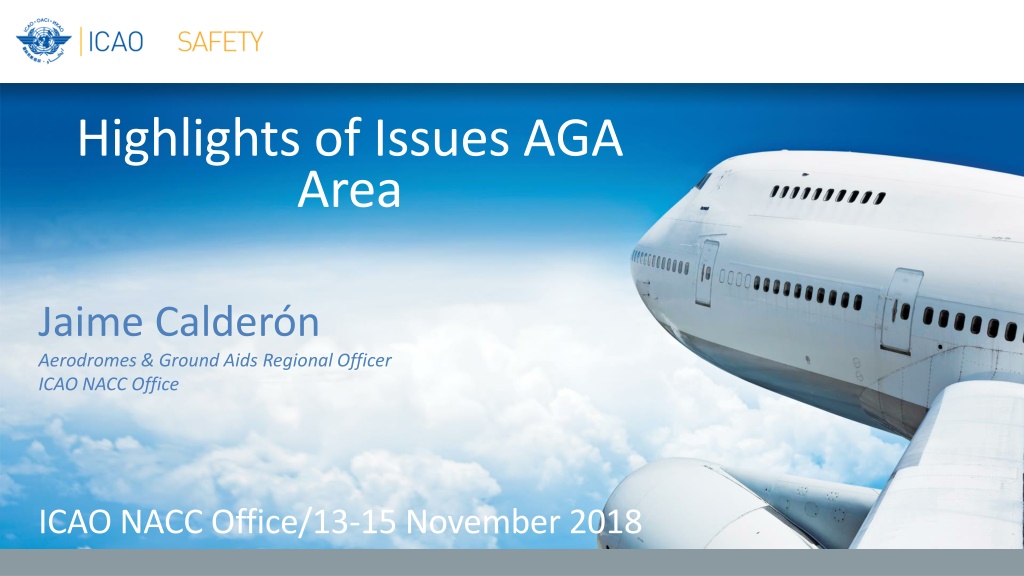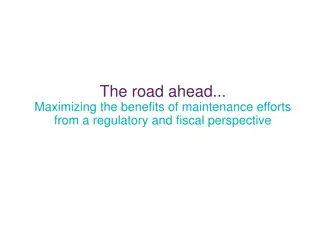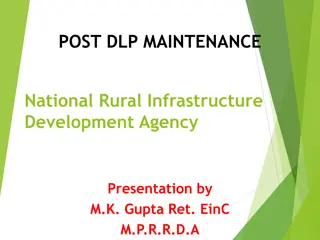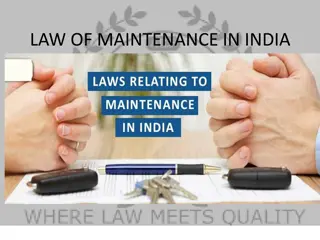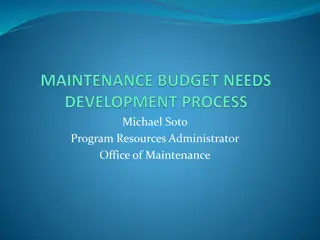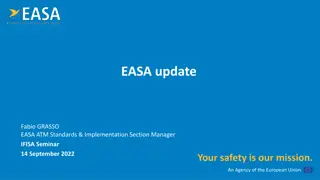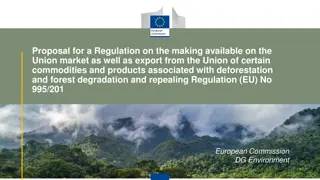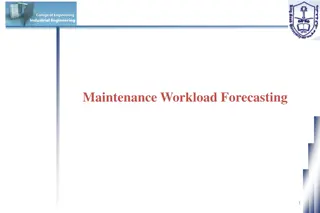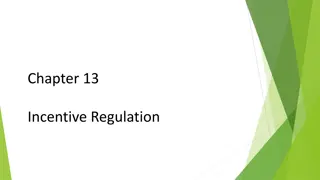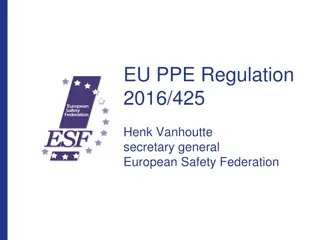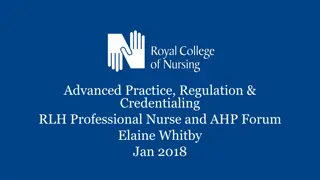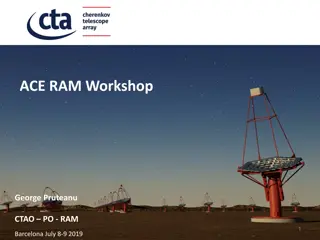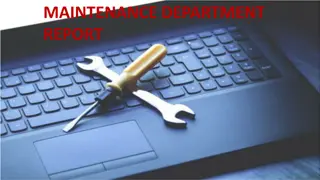Challenges in Aerodrome Regulation and Maintenance
Issues highlighted at the AGA Area conference include staffing shortages in aerodrome regulatory authorities, lack of formal training programs, deficient aerodrome certification processes, inadequate aerodrome maintenance programs, and gaps in implementing safety management systems and risk assessments. Many states exhibit shortcomings in ensuring regulatory compliance and safety measures in aerodrome operations.
- Aerodrome regulation
- Staffing shortages
- Aerodrome certification
- Maintenance programs
- Safety management systems
Download Presentation

Please find below an Image/Link to download the presentation.
The content on the website is provided AS IS for your information and personal use only. It may not be sold, licensed, or shared on other websites without obtaining consent from the author. Download presentation by click this link. If you encounter any issues during the download, it is possible that the publisher has removed the file from their server.
E N D
Presentation Transcript
Highlights of Issues AGA Area Jaime Calder n Aerodromes & Ground Aids Regional Officer ICAO NACC Office ICAO NACC Office/13-15 November 2018
Organization, staffing and training AGA: 77% of States aerodrome regulatory authorities lack sufficient human resources (including an appropriate mix of technical disciplines given the size and scope of all the aerodrome operations in the State) to carry out its functions and mandate. 57% of States aerodrome regulatory authorities have not developed a formal training programme detailing the type of training to be provided to aerodrome regulatory and inspectorate staff. The majority of the States aerodrome regulatory authorities have not developed and implemented periodic training plans to be provided during the established period.
Aerodrome certification General 57% of States have not established a process for the certification of aerodromes. Aerodrome manual: 61% of States do not ensure that aerodrome manuals are reviewed periodically to check their amendment status and that the information contained in the manual remain correct. 47% of States do not have a procedure in place for subsequent amendments to the aerodrome manual to be reviewed and approved/accepted by aerodrome regulatory authority technical staff.
Aerodrome maintenance 47% of States do not ensure that aerodrome operators develop and implement aerodrome maintenance programmes at all aerodromes in the interests of safety, efficiency and regularity of aircraft operations. 77 % of States have not established and implemented a mechanism to ensure that aerodrome operators maintain good friction characteristics and low rolling resistance on runways. 52% of States do not ensure that aerodrome operators define maintenance performance level objectives for visual aids as part of their preventive maintenance programme.
SMS/aeronautical studies/risk assessments 57% of States do not ensure that, whenever a change to the aerodrome physical characteristics, facilities or equipment is proposed, the aerodrome operator has a procedure for evaluating the impact of this change on the safety of the existing operation. Only 1 State has the requirement for certified aerodromes to have SMS implemented for all aerodromes receiving international flights. 85% of States have not established a process to review the validity of using an aeronautical study or risk assessment to justify an application for an exemption or exception as well as the continuing need. 81% of States have not established and implemented a mechanism to assess the outcomes of the conduct of risk assessments or aeronautical studies.
Guidance for Collecting and Managing Evidence and for documenting ICVM results Why collect evidence? 1. a) b) Show the progress achieved by the State since the last activity; Show that the deficiencies were eliminated for the PQ (or, if the finding is generic in nature, that the requirements of the PQ are satisfied) or show that some deficiencies previously identified for the PQ, are still present and that the PQ remains Not Satisfactory; Comply with the principles of evidence-based approach and independent sampling of evidence (cases/files/examples selected by the expert and not by the State); Enable the ICAO technical expert to review and validate the draft results for the PQ; and provide traceability for future activities or queries. c) d) e) Note: only appropriately approved documentation is acceptable as evidence.
2. Using the Progress documented box a) With due consideration of the finding (or, if the finding is generic in nature, with due consideration of the PQ and each guidance item listed for this PQ), describe the progress made by the State, and the resulting situation observed, with clear and simple sentences; When needed for the description s clarity, identify the title of the relevant document(s) (i.e. those supporting the PQ status); In case of absence of action since the last activity (ICVM or audit), it may be mentioned No evidence of progress for this PQ ; For PQs for which the status change to notapplicable , use a single sentence to document the reason why the PQ is not applicable. b) c) d)
3. a) b) c) Using the Evidence box Only mention the relevant documents; Write the document title (or short title) in the Evidence box for each relevant document; After each document title, indicate the relevant chapter number, page number and/or paragraph number, as applicable, to identify the specific location of the evidence. Example: Civil Aviation Law No. (41) of 2007, Article 12 (y) d) In addition, review of evidence of implementation (for all PQs with implementation aspects) should be reflected: in the booklets (with the details of the cases/files/examples reviewed); and in the OLF checklist (with at least a mention on-site review of XXX in the evidence box); Example 1: filled-in 2015 certification checklists of XXX Example 2: on site review of 2014 and 2015 files; e) Write Nil if no evidence was provided , and f) In the OLF, do not mention names of persons or personal indications; If evidence is provided in hard copy, write the words hardcopy at the end of the booklet Evidence box. Example: Civil Aviation Law No. (41) of 2007, Article 12 (y) (hard copy).
4. a) b) Electronic evidence Collect evidence in electronic format as much as possible. Collected electronic evidence must be saved on the USB stick supplied with the mission package. Save all the evidence related to each PQ in the relevant folder. If, and only if, a document is referred for numerous PQs (e.g. manual or regulations) as evidence, attach one electronic copy of the whole document in a generic folder ( x.000 GEN folder)) and then mention in the evidence box for each PQ, the title of the document (the title must be the same as in the x.000 GEN folder), and the relevant page or paragraph; and Ensure that each file in the folder is clearly and correctly named to show the title of the reference document. c) d) e)
5. a) Hard copy evidence Note the PQ number on the top right hand corner of hard copy evidence Arrange hard copy evidence by PQ number in ascending order, lowest PQ number on top. For large documents only available in hardcopy format, it is acceptable to collect the title page, CAA approval page and any key pages that are deemed important. If single pages are collected, make notes on hard copy evidence to identify the document title, chapter number, page number and paragraph number. b) c) d)
6. Language of collected evidence a) Evidence that is not in English, Spanish or French is difficult for ICAO staff to review. Therefore, it is preferable that the State provides translations of its documents (in the language selected by the State for conducting the audit) as much as possible. In particular, the State should submit translations of certain high- level important documents, such as: primary aviation law; and regulations and manuals (as a minimum, the table of contents or index). b)
7. Examples of evidence categorized by CE CE-1 Legislative instruments related to civil aviation activities and established entities (laws, treaties, etc.), promulgated and published versions; bilateral agreements on Article 83 bis of the Chicago Convention or other equivalent topics. CE-2 Regulatory instruments (regulations; directives); promulgated and published versions; procedures for the amendment of regulations; procedures for identifying and notifying differences, if any, to ICAO; copy of list of differences published in the AIP; policy on the granting of exemptions and examples of granted exemptions.
CE-3 Documents related to nomination, delegation, cooperation, etc. (MOU, letters, etc.); organizational charts; documents describing functions and responsibilities; sample of job descriptions; sample of credentials; documents on the authorities funding and approved budget; documents on the process to determine staffing needs; procedure for the delegation of tasks to other entities or individuals; letters of nomination or designation with respect to the delegation of tasks.
CE-4 Document defining the minimum qualification and experience requirements; document on the recruitment process; training policy; training programmes; training plans; completed OJT forms; documents on the system for keeping training records (copies of training records are not required). CE-5 Process or procedure for making necessary documents available to technical staff (annexes to the CC, regulations, etc.), document control and/or system for maintaining the documents up-to-date; inspector handbooks, procedures, checklists and other guidance material; guidance provided to the industry; link to the electronic version of the AIP;
CE-6 samples of completed check-lists used for licensing/certification/approval and/or authorization processes; copies of issued licenses, certificates, approvals and/or authorizations; copies of exchange of letters with the industry. CE-7 surveillance policy; surveillance programme and plans (past and future; plans of the past year should reflect the planned versus the completed activities); copies of inspection or audit reports and/or monitoring activities; CE-8 copies of exchange letters with the industry regarding deficiencies and corrective actions (notification and classification of deficiencies; acceptance of corrective actions, etc.); enforcement procedures;
